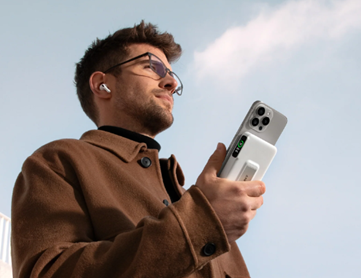Selecting a portable battery charger for travel involves more than just picking a high-capacity model. It must be a reliable power companion in unfamiliar environments, capable of handling challenges from long-haul flights to outdoor adventures. An ideal travel-oriented power bank achieves a perfect balance between energy capacity, portability, charging speed, and aviation safety regulations. It needs to quickly rejuvenate your smartphone, camera, and tablet and pass through airport security checks seamlessly while fitting into compact luggage. This guide will detail the key attributes of the perfect travel charger, helping you select a piece of gear that eliminates range anxiety and allows you to fully immerse yourself in every journey.

Airline Compliance and Smart Capacity
Understanding Capacity Limits (Wh and mAh)
The foremost consideration for a travel power bank is compliance with airline safety regulations. Most airlines restrict devices with lithium-ion batteries to a maximum of 100 watt-hours (Wh) per battery. You can usually find the capacity in milliamp-hours (mAh) on the product. To convert mAh to Wh, use the formula: (mAh * Voltage) / 1000. For a standard power bank with a 3.7V battery, a 20,000mAh model equals 74Wh, which is well under the limit and universally accepted on flights without special permission. For peace of mind, always choose a model clearly labeled as "FAA Compliant" or "Airline Approved." Carrying a power bank within these limits ensures a smooth and hassle-free security screening experience.
The Carry-On Rule and Capacity Planning
A critical and non-negotiable rule is that portable chargers must be carried in your hand luggage, never checked in. This is a crucial global safety measure. When selecting capacity, consider your trip length. A 10,000mAh power bank is sufficient for short trips with reliable outlet access, while a 20,000mAh to 26,800mAh model is ideal for longer journeys, providing multiple charges for a smartphone and even a tablet. This strategic approach ensures you have enough power without carrying unnecessary weight, keeping your hand luggage both powerful and efficient.
Fast Charging and Multi-Device Capability
Universal Fast-Charging Protocols
When traveling, time for charging is often limited. Fast-charging technology is, therefore, not a luxury but a necessity. The most versatile and important protocol to look for is USB Power Delivery (PD). USB-PD is a universal standard that supports a wide range of devices, from Android phones and iPhones to modern laptops and tablets. A power bank with a high-wattage USB-C PD port can provide a significant amount of power in a short time, allowing you to quickly recharge your devices during a layover or a coffee break. This efficiency means you can travel lighter, as you won't need to carry a separate, bulky laptop charger.
Multi-Device Charging Capability
The ideal travel companion should efficiently power multiple gadgets simultaneously. After a day of exploration, you likely need to charge your phone, camera, and power-hungry accessories like a smartwatch or wireless earbuds. A power bank with multiple output ports—typically a combination of USB-C and USB-A ports—allows you to charge several devices at once from a single source. This is incredibly convenient in situations where wall outlets are scarce, such as in airport terminals or hotel rooms with limited sockets. This feature streamlines your charging routine, saving you time and ensuring all your essential electronics are ready for the next day's adventures.

Rugged and Practical Travel-Ready Design
Build Quality for Travel Rigors
Travel inevitably involves bumps, drops, and vibrations. A power bank designed for travel should have a robust build quality to withstand these rigors. Look for features like a shock-resistant outer shell, often made from durable PC/ABS materials or aluminum. Reinforced corners can help absorb impact from accidental drops. A well-built charger is an investment in reliability, ensuring that the sensitive internal components and battery cells are protected from physical damage throughout your journeys. This durability guarantees that your power source remains functional when you need it most, in various environments from crowded cities to rugged trails.
User-Friendly Features for Convenience
Practical design details significantly enhance the travel experience. A textured or matte finish provides a secure grip and resists scratches and fingerprints. Port covers are a valuable addition, protecting the charging ports from dust, lint, and moisture when not in use. Furthermore, a clear power indicator, preferably a digital percentage display, allows for precise battery management. These thoughtful elements, along with options like integrated cables found in some models, demonstrate a design philosophy centered on real-world use, making the power bank a genuinely helpful travel accessory.
Conclusion
The ideal travel portable charger is a harmoniously designed tool that prioritizes safety, efficiency, and convenience. It adheres to airline regulations, offers a smart balance of capacity and portability, and delivers fast, simultaneous charging to all your devices through versatile ports. Features like a rugged build, integrated cables, and a precise power indicator further enhance its value on the road. By carefully considering these factors, you can select a power bank that acts as a dependable power hub, ensuring you capture every moment and stay connected seamlessly throughout your travels, no matter the destination.
NEXT: What Makes USB-C Chargers Better Than Traditional Laptop Adapters?